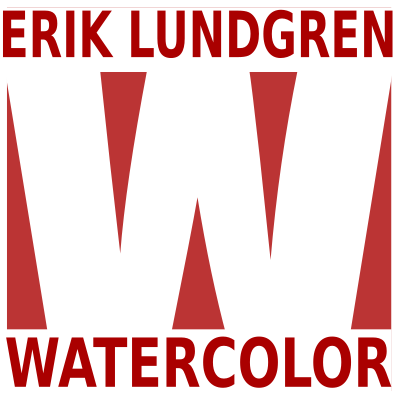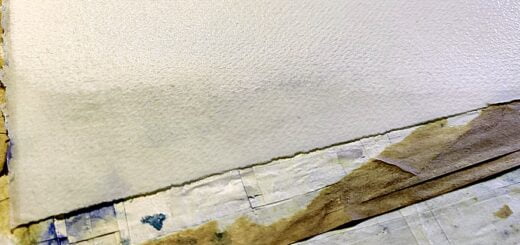Watercolor paper, texture

Watercolor paper is produced with different surfaces, ranging from smooth as window glass to rough as a gravel road. Which surface you choose is of great importance for the result. The surface of the paper affects several different aspects of painting.
Watercolor paper is usually produced with three different surfaces: Hot pressed which is very smooth, often called HP or sometimes satin. Cold-pressed, which has a little more structure than hot-pressed, is often called NOT because it is NOT hot-pressed. Finally, there is paper with a coarse grain, it is usually called Rough (Grain Torchon).
The descriptions below apply to the most common type of good watercolor paper, the so-called moldmade. Simpler machine-made paper and expensive and fine handmade paper sometimes use other methods.
Hot pressed watercolor paper
A hot-pressed paper is obtained by pressing the paper between heated steel cylinders or between highly polished cold rollers. This creates a paper that is very smooth and free of unevenness.
Such paper does not adhere the watercolor paint very well. It is quite easy to lift paint from. A smooth paper surface means it lends itself to detailed brushwork, botanical illustrators feel at home with hot pressed paper.
Hot pressed paper is less absorbent than other papers because the fibers are so tightly packed. The liquid stays on the surface and is not absorbed by the paper. This means that fine wet-on-wet transitions often become uneven and patchy. Flocculating pigments are emphasized on this paper, but on the other hand, the paper produces clear and fine colors.
Cold pressed watercolor paper
The paper gets its surface by being pressed with light pressure between felt-covered steel rollers. This process produces a paper surface that is slightly textured. It is quite easy to lift color from, but not as easy as on hot pressed.
It is probably the easiest paper to use, it is suitable for all types of watercolor painting. The paper absorbs liquid better than hot-pressed, but not as well as paper with a rough grain.
Rough watercolor paper
To create a rough surface on a watercolor paper, the still wet paper is placed between felts with a texture which gives an impression on the paper.
Because the paper is not pressed as hard as other papers, it absorbs liquid more than other watercolor papers, this means that it swells more and usually becomes more bubbly than other papers when it gets wet
The paper is good at absorbing liquid and therefore wet-on-wet transitions are smooth and nice on this type of paper. Granulating pigments also stand out on rough watercolor paper due to the textured surface.
Rough watercolor paper can be very different from different manufacturers. All of them have different structure and roughness.

Which one should you choose?
For the beginner I would recommend cold pressed paper. It is the easiest to use and is suitable for all types of painting. It is excellent for painting small and detailed, but also works decently for fluid painting in a freer style.
Hot pressed paper is the paper of illustrators, not so suitable for a freer style with a lot of fluid. Rough paper is what I prefer. I like its ability to absorb a lot of liquid, and the nice transitions this gives and that the paper brings out the granulating colors. I stretch my paper, the fact that it gets more bubbly when wet than other papers doesn’t bother me. Dry brush technique or Scumbling also works well on rough paper, it works questionably on smoother paper.













